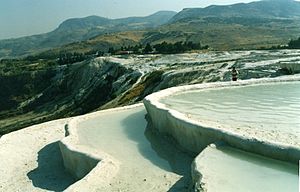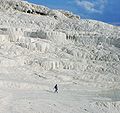- Pamukkale
-
Hierapolis-Pamukkale * UNESCO World Heritage Site
Country Turkey Type Mixed Criteria iii, iv, vii Reference 485 Region ** Europe and North America Inscription history Inscription 1988 (12th Session) * Name as inscribed on World Heritage List
** Region as classified by UNESCOPamukkale, meaning "cotton castle" in Turkish, is a natural site in Denizli Province in southwestern Turkey. The city contains hot springs and travertines, terraces of carbonate minerals left by the flowing water. It is located in Turkey's Inner Aegean region, in the River Menderes valley, which has a temperate climate for most of the year.
The ancient Greco-Roman and Byzantine city of Hierapolis was built on top of the white "castle" which is in total about 2,700 metres (8,860 ft) long, 600 m (1,970 ft) wide and 160 m (525 ft) high. It can be seen from the hills on the opposite side of the valley in the town of Denizli, 20 km away.
Tourism is and has been a major industry. People have bathed in its pools for thousands of years. As recently as the mid-20th century, hotels were built over the ruins of Heropolis, causing considerable damage. An approach road was built from the valley over the terraces, and motor bikes were allowed to go up and down the slopes. When the area was declared a World Heritage Site, the hotels were demolished and the road removed and replaced with artificial pools. Wearing shoes in the water is prohibited to protect the deposits.
Contents
Geology
 Panoramic view of travertine terraces at Pamukkale
Panoramic view of travertine terraces at Pamukkale
Pamukkale's terraces are made of travertine, a sedimentary rock deposited by water from the hot springs.
In this area, there are 17 hot water springs in which the temperature ranges from 35 °C (95 °F) to 100 °C (212 °F).[citation needed] The water that emerges from the spring is transported 320 metres (1,050 ft)[citation needed] to the head of the travertine terraces and deposits calcium carbonate on a section 60 to 70 metres (200 to 230 ft) long covering an expanse of 240 metres (790 ft) to 300 metres (980 ft). When the water, supersaturated with calcium carbonate, reaches the surface, carbon dioxide degasses from it, and calcium carbonate is deposited. The depositing continues until the carbon dioxide in the water balances the carbon dioxide in the air.[citation needed] Calcium carbonate is deposited by the water as a soft jelly,[citation needed] but this eventually hardens into travertine.
This reaction is affected by the weather conditions, ambient temperature, and the flow duration. Precipitation continues until the carbon dioxide in the thermal water reaches equilibrium with the carbon dioxide in the atmosphere. Measurements made at the source of the springs find atmospheric levels of 725 mg/l carbon dioxide, by the time this water flows across the travertines, this figure falls to 145 mg/l. Likewise calcium carbonate falls from 1200 mg/l to 400 mg/l and calcium 576.8 mg/l to 376.6 mg/l. From these results it is calculated that 499.9 mg of CaCO3 is deposited on the travertine for every liter of water. This means that for a flow rate of 1 ı/s of water 43191 grams are deposited daily. The average density of a travertine is 1.48 g/cm3 implying a deposit of 29.2 dm3. Given that the average flow of the water is 465.2 l/s this implies that it can whiten 13,584 square metres (146,220 sq ft) a day, but in practice this area coverage is difficult to attain. These theoretical calculations indicate that up to 4.9 square kilometres (1.9 sq mi) it can be covered with a white deposit of 1 millimetre (0.039 in) thickness.
Archeology
Main article: HierapolisMuseum
The former Roman Bath of the ancient city of Hierapolis has been used as the site of the Hierapolis Archaeology Museum since 1984.
In this museum, alongside historical artifacts from Hierapolis, there are also artifacts from Laodiceia, Colossae, Tripolis, Attuda and other towns of the Lycos (Çürüksu) valley. In addition to these, the museum has a large section devoted to artifacts found at Beycesultan Hüyük that includes some of the most beautiful examples of Bronze Age craft.
Artifacts from the Caria, Pisidia and Lydia regions are also on display in this museum. The museum’s exhibition space consists of three closed areas of the Hierapolis Bath and the open areas in the eastern side which are known to have been used as the library and gymnasium. The artifacts in open exhibition space are mostly marble and stone.
Tourist attraction
Pamukkale is a tourist attraction. It is recognized as a World Heritage Sites together with Hierapolis. Hierapolis-Pamukkale was made a World Heritage Site in 1988.[1]
The underground volcanic activity which causes the hot springs also forced carbon dioxide into a cave, which was called the Plutonium meaning place of the god, Pluto. This cave was used for religious purposes by priests of Cybele, who found ways to appear immune to the suffocating gas.
Tadpoles can be found in the pools.[2]
Media
-
Short video showing the Pamukkale natural site
Sister cities
The village of Pamukkale has two sister cities:
Similar places
- Geothermal areas of Yellowstone in the USA
- Pink and White Terraces in New Zealand (destroyed in 1886 by volcano eruption)
- Hierve el Agua in Mexico
- The White Whale in Italy - Bagni San Filippo (Siena)
- Baishuitai in China
Notes
- ^ "Hierapolis-Pamukkale World Heritage Site". UNESCO World Heritage Centre. http://whc.unesco.org/en/list/485. Retrieved 2007-06-23.
- ^ "Pamukkale Turkey Hotel And Hostel Redesigned". PRLog. 2009-01-10. http://www.prlog.org/10165623. Retrieved 2009-09-02.
External links
- Government Of Denizli Pamukkale official site
- Pamukkale travel guide from Wikitravel
- Film of Pamukkale - Introduction Films of Turkey - TOURISM Pamukkale Videos
- Pamukkale's 'white heaven' in danger recent newspaper article from Turkish Daily News about the danger threatening Pamukkale
- Pamukkale & Hierapolis images
- Environmental protection of geothermal waters and travertines at Pamukkale, Turkey
- Pamukkale - spherical panorama 360 degree
- UNESCO World Heritage site datasheet
- Pamukkale, The Cotton Castle - Thewotme travel blog
 UNESCO World Heritage Sites in Turkey
UNESCO World Heritage Sites in TurkeyAegean Hierapolis / Pamukkale · Xanthos / Letoon1
Black Sea Hittite Capital of Hattusa · Safranbolu
Central Anatolia Göreme and Rock Sites of Cappadocia · Great Mosque and Hospital of Divriği
Marmara Archaeological Site of Troy · Historic Areas of Istanbul · Selimiye Mosque and its Social Complex
Mediterranean Xanthos / Letoon1
Southeastern Anatolia Mount Nemrut in Commagene
1 Shared with other region/s
Wikimedia Foundation. 2010.







